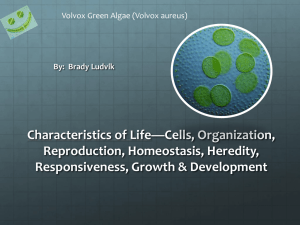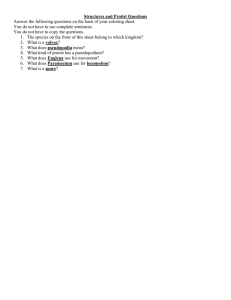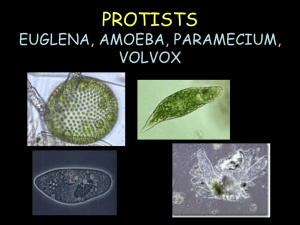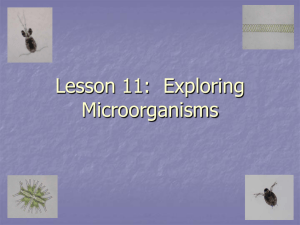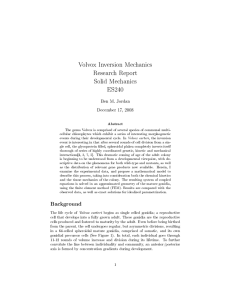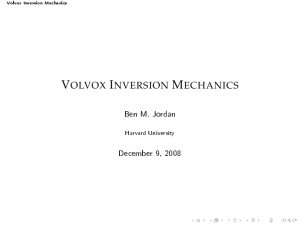Volvox Inversion Mechanics Project Proposal Solid Mechanics ES240
advertisement
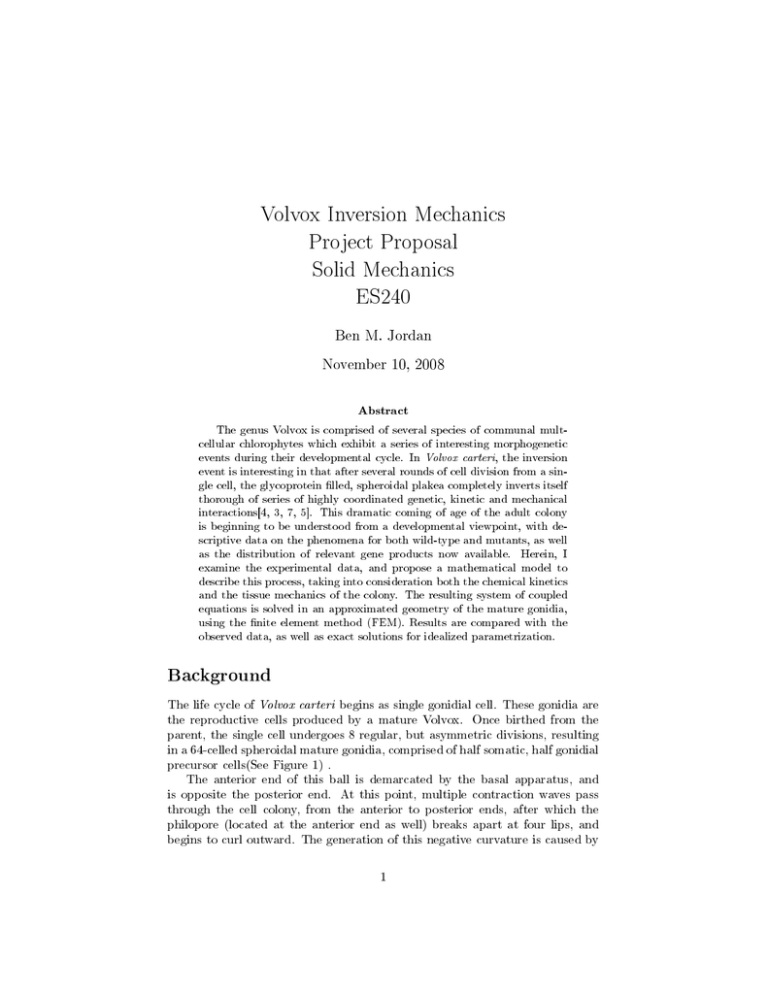
Volvox Inversion Mechanics Project Proposal Solid Mechanics ES240 Ben M. Jordan November 10, 2008 Abstract The genus Volvox is comprised of several species of communal multcellular chlorophytes which exhibit a series of interesting morphogenetic events during their developmental cycle. In Volvox carteri, the inversion event is interesting in that after several rounds of cell division from a single cell, the glycoprotein lled, spheroidal plakea completely inverts itself thorough of series of highly coordinated genetic, kinetic and mechanical interactions[4, 3, 7, 5]. This dramatic coming of age of the adult colony is beginning to be understood from a developmental viewpoint, with descriptive data on the phenomena for both wild-type and mutants, as well as the distribution of relevant gene products now available. Herein, I examine the experimental data, and propose a mathematical model to describe this process, taking into consideration both the chemical kinetics and the tissue mechanics of the colony. The resulting system of coupled equations is solved in an approximated geometry of the mature gonidia, using the nite element method (FEM). Results are compared with the observed data, as well as exact solutions for idealized parametrization. Background The life cycle of Volvox carteri begins as single gonidial cell. These gonidia are the reproductive cells produced by a mature Volvox. Once birthed from the parent, the single cell undergoes 8 regular, but asymmetric divisions, resulting in a 64-celled spheroidal mature gonidia, comprised of half somatic, half gonidial precursor cells(See Figure 1) . The anterior end of this ball is demarcated by the basal apparatus, and is opposite the posterior end. At this point, multiple contraction waves pass through the cell colony, from the anterior to posterior ends, after which the philopore (located at the anterior end as well) breaks apart at four lips, and begins to curl outward. The generation of this negative curvature is caused by 1 Figure 1: Cleavage 2 Figure 2: Inversion, pictorial and actual (SEM)[8] the change in form of the cells near the philopore, as they change from spindleshaped to ask-shaped and back to spindle-shaped. (See Figure 2). As the wave change reaches the posterior half of the colony, the posterior end snaps through the opening created, and the lips meet each other at what is now the new posterior half and rejoin. During this process, the pre-gonidial cells, which were once on the outside of the colony in the anterior half, are transported to the posterior inside of the new adult spheroid. The agellar extensions from the somatic cells, which were pointed inward in the immature gonidia, are now on the outside, allowing for locomotion of the adult spheroid. The entire process takes approximately 45 minutes. Several mutants, induced by genetic modication, and/or chemical/mechanical stimulation of the developing organism exist. One mutant form, induced by application of cytochalasin, halts or terminates the inversion process, depending on when the application is made during the process. This has been shown to be due to the ability of cytochalasin to inhibit the movement of cytosolic bridges between cells; a process crucial for the transition from spindle- to ask-shaped[8, 7] described above. Another mutant caused by the creation of a second philopore slit at the posterior half causes the inversion to begin from both ends, resulting in a toroidal adult. These phenomena represent manipulation of the mechanical and chemical interactions that are coordinated to complete inversion, and are thus predictable by a model that correctly describes the wild-type inversion process. 3 Mathematical Model I begin by considering the geometry of the mature gonidia to be nearly spheroidal, and whose outer wall is comprosed of 64 interconnected cells. This geometry is modeled as a continuous ball whose wall thickness is 10% of the radius of the ball. The slits in the philopore are also in place in the geometry under consideration, thus I begin as the uniform contraction of the wall begins to pull apart the lips (See Figure 3). Let the direction normal to the center of the slit be the anterior end, and the z-direction. Figure 3: Geometry As a rst approximation, the cell-based wall of the organism is treated as an elastic solid, for which the equations in spherical coordinates below are used. Stress-Traction tr σrr tθ = σθr tφ σφr σrθ σθθ σφθ 4 σrφ nr σθφ nθ σφφ nφ Momentum Balance ∂σr 1 ∂σrθ 1 ∂σrφ + + ∂r r ∂θ rsin(θ) ∂φ ∂σrθ 1 ∂σθ 1 ∂σθφ + + ∂r r ∂θ rsin(θ) ∂φ ∂σrφ 1 ∂σθφ 1 ∂σφ + + ∂r r ∂θ rsin(θ) ∂φ + 1r ((σθ − σφ )cot(θ) + 3σrθ ) = + 1r (3σrφ + 2σθφ cot(θ)) = Strain-Displacement εr = εθ = εφ = εθφ = εφr = εrθ = ∂ur ∂r 1 ∂uθ + ur r ∂θ ∂uφ 1 + ur sin(θ) + uθ cos(θ) rsin(θ) ∂φ 1 ∂uφ 1 ∂uθ − uφ cot(θ) + 2r ∂θ sin(θ) ∂φ uφ 1 ∂ur 1 ∂uφ − + 2 ∂r r rsin(θ) ∂φ 1 1 ∂ur ∂uθ uθ + +− 2 r ∂θ ∂r r Hooke's Law εr = εθ = εφ = εφr = εrθ = εθφ = ∂ 2 ur ∂t2 ∂ 2 uθ ρ 2 ∂t ∂ 2 uφ ρ 2 ∂t + 1r (2σr − σφ − σθ − σrθ cot(θ)) = ρ 1 [σr − ν(σθ + σφ )] + α∆T E 1 [σθ − ν(σr + σφ )] + α∆T E 1 [σφ − ν(σr + σθ )] + α∆T E 1+ν σφr E 1+ν σrθ E 1+ν σθφ E 5 The contraction, as well as the material properties of the wall are controlled by the concentration of various chemical factors within the organism[6, 5, 2, 1]. These range from simple ions, such as calcium, to large protein complexes, which both either diuse or remain in a single cell. During the interim of this project, the details of the relevant kinetic components will be explored, likely resulting in several species which interact with each other. This system of reactions is modeled using Michaelis-Menten kinetics, and thus is represented by a reactiondiusion-advection system of the form ∂c ∂t = D∇2 c + c∇ ∂u + R(c), ∂x where c is the vector of the chemical species considered, D is the diusion coecient, and R(c) is a per-species reaction function. The interaction between the contraction and material properties of the spheroid are also to be determined by the literature. This results in a system of equations which are bidirectionally coupled between the displacements and the concentrations. There are several symmetries in this system which we can exploit to perform analysis and reduce the computational complexity. Since the problem is symmetric in each octant, I can reduce the analysis to one octant of the spheroid, and can thus reduce the computational, but not analytical complexity of the problem signicantly. Some work will be put into exploring a two-dimensional approximation of this system, but the asymmetry of the philopore lips will make this an approximation. Expected Results Using the proposed model, and the information yet to be determined by the literature, I hope to be able to predict the wild-type inversion process up to the point at which the lips meet and the displacement is complete. With this in place, I will simulate the equivalent processes that bring about the mutations described above, and see if my model predicts the mutant phenotype. I will also attempt to solve the equations using an approximation, and will compare these to the simulated prediction. Several improvements to this model may be considered, given the time to completion of these rst steps. The use of the Hookean elastic model for the constitutive equation may be an oversimplication resulting in an incorrect stress distribution. This is assumed because the material of the wall is known to relax and reorganize its connectivity during the inversion process. A more accurate hyperelastic or viscoelastic material model may be considered. Additionally, other geometries than perfectly spherical may be analyzed. 6 References [1] Douglas G Cole and Mark V Reedy. Algal morphogenesis: how volvox turns itself inside-out. Curr Biol, 13(19):R770R772, Sep 2003. [2] Armin Hallmann. Morphogenesis in the family volvocaceae: dierent tactics for turning an embryo right-side out. Protist, 157(4):445461, Oct 2006. [3] G. W. Ireland and S. E. Hawkins. Inversion in volvox tertius: the eects of con a. J Cell Sci, 48:355366, Apr 1981. [4] D. Kirk. Volvox. Cambridge University Press, 1998. [5] D. L. Kirk and J. F. Harper. Genetic, biochemical, and molecular approaches to volvox development and evolution. Int Rev Cytol, 99:217293, 1986. [6] Ghazaleh Nematollahi, Arash Kianianmomeni, and Armin Hallmann. Quantitative analysis of cell-type specic gene expression in the green alga volvox carteri. BMC Genomics, 7:321, 2006. [7] I. Nishii and S. Ogihara. Actomyosin contraction of the posterior hemisphere is required for inversion of the volvox embryo. Development, 126(10):2117 2127, May 1999. [8] Ichiro Nishii, Satoshi Ogihara, and David L Kirk. A kinesin, inva, plays an essential role in volvox morphogenesis. Cell, 113(6):743753, Jun 2003. 7
